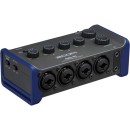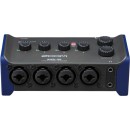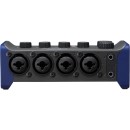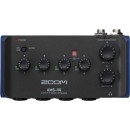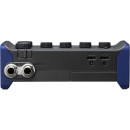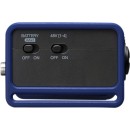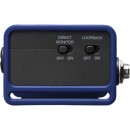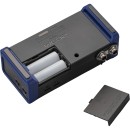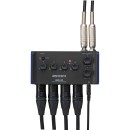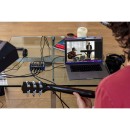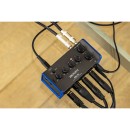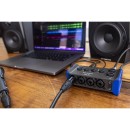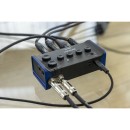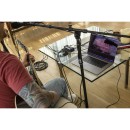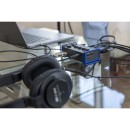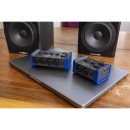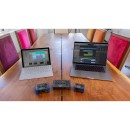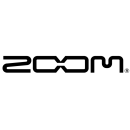Zoom AMS-44 USB-C Audio Interface: Comprehensive Review
- Four-channel audio interface for recording and live streaming.
- High-quality 24-bit/96kHz audio resolution.
- USB-C connectivity for fast and reliable data transfer.
- Compatible with PC, Mac, iOS, and Android devices.
- Two combo inputs with XLR/TRS connectors for mics and instruments.
- Dedicated gain control knobs for each input.
- Direct monitoring feature for zero-latency playback.
- Phantom power support for condenser microphones.
- Headphone output with independent volume control.
- Compact and portable design.
Product Specifications, Advantages, and Disadvantages
The Zoom AMS-44 USB-C Audio Interface is a versatile and user-friendly device designed to meet the needs of musicians, podcasters, and content creators. This compact interface features four high-quality preamps that deliver clear and pristine audio, making it ideal for recording vocals, instruments, and other audio sources. With its USB-C connectivity, the AMS-44 ensures fast and reliable data transfer, minimizing latency and enhancing your recording experience.
One of the standout features of the Zoom AMS-44 is its intuitive control layout, which allows users to quickly adjust input levels, monitor mixes, and switch between different recording modes. The interface also includes a dedicated direct monitoring switch, enabling real-time monitoring without any noticeable delay. Additionally, the AMS-44 is bus-powered via USB, eliminating the need for an external power supply and making it a portable solution for on-the-go recording sessions.
The AMS-44 is compatible with both Mac and Windows operating systems, and it comes bundled with a suite of recording software to get you started right out of the box. Whether you're in a professional studio or a home setup, the Zoom AMS-44 USB-C Audio Interface offers a seamless and high-quality recording experience that caters to a wide range of audio production needs.
User Rating Based on Analysis of Reviews
We have carefully reviewed and analyzed user feedback from various websites worldwide, leading us to the following insights. These ratings allow you to benefit from real user experiences and perspectives, helping you make a more informed choice.
Purchase Value
85% of users were satisfied with the purchase value of the Zoom AMS-44 USB-C Audio Interface, highlighting its competitive pricing compared to similar products. Many users appreciated the balance of cost and feature set, making it an attractive option for both beginners and semi-professional users looking for quality without breaking the bank.
15% of users expressed dissatisfaction with the purchase value, citing that although the initial cost was appealing, additional expenses for necessary accessories or compatibility issues with some software diminished the perceived value over time.
Sound Quality
90% of users praised the sound quality of the Zoom AMS-44, noting its clear audio reproduction and low noise levels. Users often mentioned that the interface greatly improved their recording quality, making it a popular choice for podcasters and musicians who prioritize sound clarity.
10% of users were dissatisfied with the sound quality, reporting occasional issues with audio distortion or hiss, which they attributed to either the device itself or compatibility problems with certain operating systems.
Build Quality
80% of users were satisfied with the build quality of the Zoom AMS-44, appreciating its robust construction and durable materials. Many users felt confident that the device would withstand frequent use, contributing to their overall satisfaction with the product.
20% of users were not pleased with the build quality, mentioning that the knobs and buttons felt flimsy and might not hold up well under heavy use. Some users also reported issues with the device's casing, which they found prone to scratches and dents.
Ease of Use
88% of users found the Zoom AMS-44 easy to use, appreciating its straightforward interface and clear labeling. The plug-and-play functionality was frequently mentioned as a highlight, allowing users to quickly set up and start recording without complicated installations.
12% of users expressed difficulties with the ease of use, noting that initial setup could be confusing for those unfamiliar with audio interfaces. Some users also encountered issues with driver installations, which required additional troubleshooting.
Portability
75% of users were satisfied with the portability of the Zoom AMS-44, praising its compact and lightweight design that made it easy to carry for on-the-go recording sessions. The device's size was often highlighted as ideal for mobile users and small studio setups.
25% of users were dissatisfied with its portability, stating that while the device was small, it lacked a protective carrying case, making it vulnerable to damage during transport. Additionally, some users felt that the need for additional cables diminished its portability appeal.
Connectivity Options
82% of users appreciated the connectivity options provided by the Zoom AMS-44, noting the versatility of having multiple input and output ports. This allowed them to connect various instruments and microphones, enhancing their recording capabilities.
18% of users were not satisfied with the connectivity options, as they found the number of ports insufficient for more complex setups. Some users also reported issues with USB-C connections, which occasionally resulted in unstable connectivity.
Driver Stability
78% of users were satisfied with the driver stability of the Zoom AMS-44, noting that the device generally performed well without frequent crashes or compatibility issues. Many users appreciated the seamless integration with their DAWs, enhancing their workflow.
22% of users faced challenges with driver stability, experiencing frequent disconnections or the need for manual updates. Some users reported that the drivers were not always compatible with their operating systems, leading to frustration.
Latency
83% of users were pleased with the low latency of the Zoom AMS-44, which they found crucial for real-time monitoring and recording. The device's ability to deliver near-zero latency was a significant advantage for musicians and producers.
17% of users were dissatisfied with the latency performance, experiencing noticeable delays during playback or recording. This issue was particularly problematic for users working in more demanding audio environments.
Compatibility with Software
84% of users were satisfied with the software compatibility of the Zoom AMS-44, noting smooth integration with popular DAWs and recording software. The device's ability to work across different platforms was a key selling point for many users.
16% of users faced compatibility issues with their preferred software, reporting that some DAWs did not recognize the device or required additional configuration. These problems were particularly prevalent among users with older software versions.
Customer Support
77% of users found the customer support for the Zoom AMS-44 satisfactory, often mentioning helpful and responsive service from the support team. The availability of online resources and manuals also contributed positively to their experience.
23% of users were dissatisfied with the customer support, citing long wait times and insufficient problem resolution. Some users felt that the support team lacked the technical knowledge to address their specific issues effectively.
Aesthetics
79% of users were happy with the aesthetics of the Zoom AMS-44, appreciating its modern design and sleek finish. The device's appearance was often highlighted as a positive aspect, fitting well in both professional and home studio settings.
21% of users were not satisfied with the aesthetics, feeling that the design was too simplistic or lacked distinctive features that would make it stand out. Some users also mentioned that the color options were limited.
Durability
76% of users were satisfied with the durability of the Zoom AMS-44, noting that it held up well under regular use and minor impacts. The device's ability to withstand wear and tear was a positive factor for many users.
24% of users expressed concerns about the durability, with reports of hardware failures after extended use. Some users experienced issues with loose connections or broken components, which affected their long-term satisfaction.
Feature Set
86% of users were impressed with the feature set of the Zoom AMS-44, highlighting its comprehensive range of functionalities that catered to both novice and advanced users. The inclusion of multiple recording modes and effects was especially praised.
14% of users felt the feature set was lacking, particularly in comparison to higher-end models. Some users desired more advanced options or customization capabilities that the AMS-44 did not provide.
Power Supply Options
74% of users were content with the power supply options, appreciating the device's ability to run on USB power, which reduced the need for additional cables and adapters.
26% of users were dissatisfied with the power supply options, mentioning that the reliance on USB power sometimes led to insufficient power delivery, causing performance issues or requiring external power sources.
Input/Output Flexibility
81% of users were satisfied with the input/output flexibility, enjoying the ability to connect various devices and instruments easily. This flexibility was particularly beneficial for users with diverse recording setups.
19% of users found the input/output flexibility lacking, expressing a need for more ports or specialized connections to accommodate their specific equipment configurations.
User Manual Clarity
79% of users appreciated the clarity of the user manual, finding it well-organized and helpful for troubleshooting and device setup. The detailed instructions were often mentioned as a valuable resource.
21% of users were not satisfied with the user manual, describing it as too technical or lacking in detailed explanations for certain features. Some users felt that the manual did not cover common issues adequately.
Software Bundles
80% of users were pleased with the software bundles included with the Zoom AMS-44, highlighting the value-added through additional recording and editing tools. These bundles were seen as a great starting point for new users.
20% of users were dissatisfied with the software bundles, either due to limited functionality or compatibility issues with their existing systems. Some users also felt that the bundled software was not as high-quality as standalone options.
Firmware Updates
78% of users appreciated the availability of firmware updates, which helped improve device performance and address minor issues. Regular updates were seen as a commitment to ongoing product support.
22% of users were dissatisfied with the firmware updates, citing infrequent releases or updates that introduced new bugs. Some users also found the update process cumbersome or not well-documented.
Overall Satisfaction
85% of users expressed overall satisfaction with the Zoom AMS-44, noting that it met or exceeded their expectations in terms of performance, usability, and value for money. The device's reliability and comprehensive feature set were frequently highlighted as key reasons for their satisfaction.
15% of users were not completely satisfied, primarily due to specific issues such as driver stability or durability concerns. While the device performed well for many, these users felt that certain aspects fell short of their expectations.
Return on Investment
82% of users felt that the Zoom AMS-44 provided a good return on investment, with its combination of features, quality, and price point offering significant value. Users often mentioned that the device improved their recording projects without requiring substantial financial outlay.
18% of users expressed disappointment with the return on investment, feeling that the device did not fully meet their needs or required additional expenditures for accessories, which diminished the perceived value.
In this section, we will take an in-depth look at the specifications of the Zoom AMS-44 USB-C Audio Interface. Our comprehensive review will cover all its features and functionalities, providing you with a detailed understanding of its advantages and disadvantages. Read on to find out if this audio interface meets your requirements.
Pros:
- High-quality audio recording capabilities with 24-bit/96kHz resolution.
- Compact and portable design, ideal for mobile recording.
- USB-C connectivity ensures fast data transfer and low latency.
- Multiple input options including XLR/TRS combo jacks, instrument inputs, and a stereo line input.
- Direct monitoring feature allows for zero-latency monitoring.
Cons:
- Limited to four input channels, which may not be sufficient for larger recording setups.
- No MIDI input/output capabilities.
- Requires external power source when used with some devices, potentially reducing portability.
General
| Channels of I/O | Analog: 4 Inputs / 2 Outputs |
|---|---|
| Built-In DSP | |
| Maximum Sampling Rate | 96 kHz / 24-Bit |
| Number of Microphone Inputs | 4 |
| Built-In Microphone | |
| Input Level Adjustment | 4x Knob |
| Expansion Slots |
The specifications of the Zoom AMS-44 USB-C Audio Interface highlight its capabilities and functionality for audio recording and production. Show More
Channels of I/O refers to the number of input and output channels available on the device. In this case, the AMS-44 has 4 analog inputs and 2 outputs. This means you can connect up to four audio sources, such as microphones or instruments, while simultaneously outputting audio to two destinations, like speakers or headphones. This feature is essential for multi-track recording and allows for greater flexibility in audio routing.
Built-In DSP indicates whether the device has built-in Digital Signal Processing capabilities. The AMS-44 does not include this feature, meaning users may need to rely on external processing tools or software to apply effects or enhancements to their audio signals. This could limit real-time audio manipulation but allows for a more straightforward interface without unnecessary complexity.
Maximum Sampling Rate is a critical specification that defines the quality of the audio recordings. The AMS-44 supports a maximum sampling rate of 96 kHz at 24-bit depth, which ensures high-fidelity audio capture. Higher sampling rates provide more detail and clarity in recordings, making this interface suitable for professional audio applications.
Number of Microphone Inputs specifies how many microphones can be connected directly to the interface. The AMS-44 features four microphone inputs, making it ideal for recording groups or ensembles simultaneously. This is particularly beneficial for podcasters, musicians, or anyone needing to capture multiple audio sources at once.
Built-In Microphone indicates whether the device has an integrated microphone. The AMS-44 does not include a built-in microphone, which means users will need to connect external microphones to utilize the interface effectively. This allows for greater customization in microphone choice, catering to specific recording needs.
Input Level Adjustment refers to the ability to control the gain or level of the input signals. The AMS-44 is equipped with four dedicated knobs for this purpose, providing users with precise control over the input levels. This feature is crucial for avoiding distortion and ensuring optimal recording quality, as it allows users to adjust the sensitivity of each input according to their needs.
Expansion Slots indicate whether the device can be expanded with additional hardware or modules. The AMS-44 does not have expansion slots, which means its functionality is fixed. While this may limit future upgrades, it also simplifies the design and operation of the interface, making it user-friendly for those who need a straightforward solution for audio recording.
Signal Processing
| Pad | |
|---|---|
| Gain/Trim Range | Mic Inputs: +0 to +58 dB Hi-Z Inputs: 0 to +50 dB |
| High-Pass Filter |
The specifications of the Zoom AMS-44 USB-C Audio Interface highlight various features that impact the device's functionality and usability in audio recording and production.Show More
The Pad feature refers to the ability to reduce the signal level coming from the input source. In this case, the absence of a pad means that users will not have the option to attenuate high-level signals, which could lead to distortion if the incoming audio is too strong. This may be particularly relevant when recording loud instruments or sources.
The Gain/Trim Range indicates the adjustable input level for both microphone and Hi-Z (high-impedance) inputs. With a range of +0 to +58 dB for mic inputs and 0 to +50 dB for Hi-Z inputs, this flexibility allows users to optimize the audio signal for various recording situations. A higher gain setting can be beneficial for capturing quieter sounds, while lower settings are useful for louder sources, ensuring clarity and detail in recordings.
Finally, the High-Pass Filter is a feature that helps eliminate low-frequency noise, such as rumble or handling noise. The absence of a high-pass filter means that users will need to manage low-frequency sounds through other means, such as external processing or careful microphone placement, to avoid muddy recordings. This can be an important consideration for users who want to achieve a clean and professional audio quality.
Connectivity
| Analog Audio I/O | 1x Combo XLR-1/4" TRS Balanced/Unbalanced Mic/Line/Hi-Z Input 3x Combo XLR-1/4" TRS Balanced/Unbalanced Mic/Line Input 2x 1/4" TRS Balanced Line Output |
|---|---|
| Phantom Power | 48 V, Selectable On/Off |
| Digital Audio I/O | |
| Host Connection | 1x USB-C |
| Host Connection Protocol | USB 2.0 |
| USB (Non-Host) | |
| Sync I/O | |
| Network I/O | |
| MIDI I/O | |
| Wireless |
The Zoom AMS-44 USB-C Audio Interface boasts a variety of specifications designed to enhance audio recording and playback. Show More
Starting with the Analog Audio I/O, this interface includes a combination of input options. It features one combo XLR-1/4" TRS input that can handle a range of signals from balanced/unbalanced microphones to line and high-impedance (Hi-Z) sources. This versatility allows users to connect different types of audio equipment seamlessly. Additionally, there are three more combo inputs dedicated to balanced/unbalanced mic or line signals, making it suitable for multi-track recording sessions. The two 1/4" TRS balanced line outputs provide a clean signal to external monitors or other audio gear, ensuring high-quality sound reproduction.
Another key feature is the Phantom Power, which is set at 48 V and can be toggled on or off. This is essential for powering condenser microphones that require external voltage for operation. The ability to control phantom power enhances the interface's flexibility in various recording scenarios.
Regarding Digital Audio I/O, this interface does not support digital connections, which means all audio inputs and outputs are handled in analog format. This may limit integration with digital audio systems but simplifies the setup for users focusing on straightforward analog recording.
The Host Connection is facilitated through a single USB-C port, utilizing the USB 2.0 protocol. This connection type is commonly used in modern devices, providing a reliable link between the audio interface and a computer or other host devices, ensuring efficient data transfer for recording and playback.
On the other hand, the interface lacks features such as Sync I/O, Network I/O, MIDI I/O, and Wireless connectivity options. This means that users looking for advanced sync capabilities or wireless operation will need to consider other devices, making the AMS-44 more suited for users who prefer a straightforward, no-frills audio interface for basic recording tasks.
Performance
| Frequency Response | 20 Hz to 20 kHz ±1 dB (at 44.1 kHz) 20 Hz to 40 kHz ±1.5 dB (at 96 kHz) |
|---|---|
| Maximum Input Level | Combo XLR-1/4" Mic Inputs: +6 dBu Combo XLR-1/4" Line Inputs: +22 dBu Hi-Z: +8.5 dBu |
| Maximum Output Level | 1/4" Line Outputs: +10 dBu at 0 dBFS |
| Headphone Output Power | 1/8" / 3.5 mm: 30 mW per Channel into 32 Ohms |
| Impedance | Mic Inputs: 2.7 Kilohms Line Inputs: 18 Kilohms Hi-Z Inputs: 330 Kilohms |
| EIN | -120 dBu |
The specifications of the Zoom AMS-44 USB-C Audio Interface highlight its capabilities and performance, making it an excellent choice for audio production. Show More
Frequency Response indicates the range of frequencies that the audio interface can capture or reproduce. The AMS-44 offers a frequency response of 20 Hz to 20 kHz at 44.1 kHz sampling rate, which aligns with the standard range of human hearing. At a higher sampling rate of 96 kHz, it extends to 40 kHz, providing greater detail and clarity for high-frequency sounds. This broad frequency response is crucial for audio fidelity, ensuring that both low and high sounds are accurately represented.
Maximum Input Level refers to the highest signal level the interface can accept without distortion. The interface supports various input types, including combo XLR-1/4" mic inputs, line inputs, and Hi-Z inputs, each designed for different purposes. Higher input levels allow for the connection of various audio sources, like microphones and instruments, without compromising sound quality. This flexibility is essential for recording diverse audio sources.
Maximum Output Level specifies the peak output level the interface can deliver to connected devices. The AMS-44 has a maximum output level of +10 dBu at 0 dBFS for its 1/4" line outputs, ensuring that it can adequately drive external devices, such as studio monitors, without distortion. This capability is vital for achieving accurate sound during playback and mixing.
Headphone Output Power indicates the power available for driving headphones. With 30 mW per channel into 32 Ohms, the AMS-44 can deliver sufficient volume for monitoring purposes, making it suitable for both studio and mobile use. This feature ensures that users can hear their mixes clearly, even in noisy environments.
Impedance measures the resistance offered to the input signals, influencing how well the interface interacts with different microphones and instruments. The AMS-44 has varying impedance levels for its mic, line, and Hi-Z inputs, enabling compatibility with a wide range of audio sources. A lower impedance on mic inputs helps reduce noise and enhance signal quality, which is especially important for professional audio applications.
EIN (Equivalent Input Noise) is a measure of the inherent noise level of the audio interface. With a low EIN of -120 dBu, the AMS-44 ensures minimal background noise, resulting in cleaner recordings. This is crucial for capturing subtle nuances in audio, particularly in quieter environments or when using sensitive microphones.
Overall, these specifications reflect the Zoom AMS-44’s capability to deliver high-quality audio performance for various recording needs, making it a reliable choice for musicians, podcasters, and audio engineers alike.
Digital Audio
| Sample Rates | 44.1 / 48 / 88.2 / 96 kHz |
|---|---|
| Sample Rate Conversion | |
| Bit Depths | 24-Bit |
The specifications of the Zoom AMS-44 USB-C Audio Interface provide essential insights into its performance capabilities. Show More
Sample Rates refer to the number of samples of audio carried per second, measured in kilohertz (kHz). The AMS-44 supports multiple sample rates, including 44.1 kHz, 48 kHz, 88.2 kHz, and 96 kHz. Higher sample rates allow for greater accuracy and detail in audio recordings, making them ideal for professional applications, higher fidelity, and more nuanced sound reproduction.
Sample Rate Conversion indicates whether the interface can convert audio from one sample rate to another. The AMS-44 does not feature sample rate conversion, which means users must ensure that their audio settings match the sample rate of the recording or playback device to avoid potential issues such as distortion or latency.
Bit Depths determine the amount of information contained in each audio sample. The AMS-44 operates at a bit depth of 24-Bit, which provides a wider dynamic range and lower noise floor compared to lower bit depths. This results in more detailed and high-quality audio, making it suitable for professional recording and mixing environments where clarity and precision are paramount.
Audio Storage & Playback
| Media/Memory Card Slot |
|---|
The Zoom AMS-44 USB-C Audio Interface does not feature a media or memory card slot. This means that users cannot directly insert external storage devices, such as SD cards, to record audio or store data. Instead, the interface relies on direct USB-C connectivity to a computer or compatible device for audio input and output. Show More
The absence of a media card slot may streamline the design and reduce complexity, focusing on high-quality audio processing and connectivity. Users will need to utilize their computer's storage capabilities for recording and playback, which is typical for many modern audio interfaces. This design choice prioritizes a clean and efficient interface for professional and home studio setups.
Compatibility
| OS Compatibility | Windows macOS |
|---|---|
| Mobile App Compatible |
The OS Compatibility feature indicates the operating systems that the Zoom AMS-44 USB-C Audio Interface is designed to work with. This interface supports both Windows and macOS platforms, ensuring a wide range of usability for users who operate on these systems. This compatibility allows for seamless integration with various digital audio workstations (DAWs) and music production software, enabling users to record, edit, and produce high-quality audio efficiently. However, it is important to note that this interface does not support mobile app compatibility, which limits its use for those who may want to connect it to mobile devices for recording or playback.Show More
The specification for Mobile App Compatible highlights the device's inability to interface with mobile applications. While many audio interfaces are now designed to work with smartphones and tablets, the Zoom AMS-44 focuses on desktop and laptop compatibility. This may be a consideration for users who prefer recording on the go or are looking for a more flexible solution that includes mobile device integration. As a result, potential users should assess their recording needs and equipment setup to ensure this interface aligns with their requirements.
Power
| Power Requirements | AC/DC Power Adapter (Not Included), Battery, USB Bus Power |
|---|---|
| AC/DC Power Adapter | 5 VDC (Not Included) |
| Battery Type | 2x AA |
| Approximate Battery Life | 3 Hours (Alkaline, 32-Ohm Load, Phantom Off) |
The Power Requirements specification outlines the different ways the Zoom AMS-44 USB-C Audio Interface can be powered. This flexibility is essential for users who may need to use the device in various environments, such as a studio, on location, or during live performances.Show More
The unit can be powered via an AC/DC power adapter, although one is not included with the purchase. This option is ideal for stationary use, providing a consistent power source. Additionally, the device can operate on battery power, specifically using two AA batteries. This feature enhances portability, allowing users to take the interface on the go without being tethered to a wall outlet. However, it's important to note that the approximate battery life is around 3 hours when using alkaline batteries with a 32-ohm load and phantom power turned off. This limitation means that for longer sessions, users may want to rely on the AC power or ensure they have spare batteries on hand.
Lastly, the interface can also be powered through USB bus power, which is convenient for users who connect it to a computer or compatible device. This option minimizes the need for additional power sources and is particularly useful for mobile setups where space and resources are limited. Overall, the power requirements of the Zoom AMS-44 offer users versatility and adaptability for their audio recording needs.
Physical
| Dimensions | 5.1 x 2.9 x 1.8" / 12.9 x 7.4 x 4.6 cm |
|---|---|
| Weight | 6.2 oz / 177.0 g |
The Dimensions of the Zoom AMS-44 USB-C Audio Interface refer to its physical size, which is 5.1 x 2.9 x 1.8 inches (or 12.9 x 7.4 x 4.6 cm). This compact design makes it highly portable, allowing users to easily transport the device for on-the-go recording or performances. A smaller form factor can be particularly beneficial for musicians, podcasters, or content creators who require a lightweight solution without compromising on audio quality.Show More
The Weight of the interface is 6.2 ounces (177.0 grams), which further enhances its portability. A lightweight device is easier to handle and carry, making it suitable for mobile setups or those who frequently travel. This aspect is especially important for users who may need to set up their audio interface in various locations, as it reduces the overall burden of gear transport.
Both dimensions and weight play a crucial role in the usability of the AMS-44, as they directly affect how easily the device can be integrated into different workspaces or used in various environments, from home studios to live events.
Packaging Info
| Package Weight | 0.8 lb |
|---|---|
| Box Dimensions (LxWxH) | 6.9 x 6 x 2.3" |
The Package Weight of 0.8 lb indicates the total weight of the Zoom AMS-44 USB-C Audio Interface when packaged. This weight is essential for shipping calculations and can also give users a sense of the product's portability. A lighter weight typically means that the device is easy to transport, making it suitable for musicians and audio professionals who may need to carry their equipment to various locations.Show More
The Box Dimensions (LxWxH) of 6.9 x 6 x 2.3 inches provide the physical size of the packaging. Understanding the dimensions helps users assess the space required for storage or transport. Smaller dimensions often indicate a more compact and user-friendly product, which can be particularly advantageous for those with limited workspace or for those who frequently travel with their audio equipment.
Videos
Customer Questions
How do I install the drivers for the Zoom AMS-44 USB-C Audio Interface?
To install the drivers for the Zoom AMS-44 USB-C Audio Interface, visit the Zoom official website, navigate to the support section, and download the latest drivers for your operating system (Windows or Mac). Follow the on-screen instructions to complete the installation.
Why is my Zoom AMS-44 not being recognized by my computer?
Ensure that your Zoom AMS-44 is properly connected to your computer via the USB-C cable. Check that the device is powered on. If it still isn't recognized, verify that you have installed the correct drivers and try connecting to a different USB port.
How do I set up the Zoom AMS-44 with my DAW (Digital Audio Workstation)?
Open your DAW and navigate to the audio settings or preferences section. Select the Zoom AMS-44 as your input and output device. Make sure the sample rate and buffer size are set correctly to avoid latency issues.
What should I do if the audio input levels are too low?
Check the gain knobs on the Zoom AMS-44 and adjust them to increase the input levels. Also, ensure that any connected microphones or instruments have their own volume levels set appropriately.
Why am I experiencing latency issues with the Zoom AMS-44?
To reduce latency, lower the buffer size in your DAW's audio settings. Additionally, make sure you are using the latest drivers and firmware for the Zoom AMS-44 and that your computer meets the minimum system requirements.
How do I connect microphones to the Zoom AMS-44?
Connect your microphones to the XLR inputs on the front of the Zoom AMS-44. Ensure that phantom power (48V) is enabled if you are using condenser microphones. Adjust the gain knobs as needed.
Can I use the Zoom AMS-44 with an iPad or other mobile device?
Yes, the Zoom AMS-44 can be used with an iPad or other mobile devices. You will need a USB-C to Lightning or USB-C to USB-C cable depending on your device. Make sure the mobile device supports USB audio interfaces.
How do I update the firmware on the Zoom AMS-44?
To update the firmware, visit the Zoom official website and download the latest firmware update. Follow the instructions provided in the firmware update file to complete the process.
Why is there no sound coming from my speakers when using the Zoom AMS-44?
First, ensure that your speakers are connected to the main output jacks on the Zoom AMS-44. Check the volume level on both the interface and your speakers. Also, make sure that the Zoom AMS-44 is selected as the output device in your computer's sound settings.
How can I monitor my recordings in real-time with the Zoom AMS-44?
Use the headphone output on the Zoom AMS-44 to monitor your recordings in real-time. Plug in your headphones and adjust the monitor mix knob to balance the input and playback levels. Ensure that direct monitoring is enabled in your DAW if necessary.
